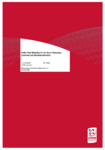Wairarapa Active Fault Mapping
Search in document library
Purpose: To provide updated mapping of active faults in the Wairarapa region for land-use planning and hazard mitigation.
Geographic Coverage: South Wairarapa, Carterton, and Masterton Districts in the Greater Wellington Region, New Zealand.
This report presents updated mapping of active faults across the South Wairarapa, Carterton, and Masterton Districts. Using high-resolution LiDAR data, GNS Science identified numerous fault traces, including previously known faults such as the Wairarapa, Wellington, Masterton, Carterton, Mokonui, Te Maire, and Martinborough Faults, as well as newly recognised faults like the Papawai, Woodside, Carters Line, Ruamahanga, Morison Hill, Wharekauhau East, and Mangatarere faults. The mapping revealed that some previously identified faults lack visible surface traces and are now considered inactive. Fault Avoidance Zones (FAZs) and Fault Awareness Areas (FAAs) were developed to guide land-use planning. FAZs were created for faults with well-defined surface rupture potential, while FAAs indicate areas where further investigation is recommended. The report categorises faults by recurrence interval classes, ranging from Class I (≤2000 years) to Class V (>10,000 to ≤20,000 years), with most classifications based on geomorphic evidence and expert judgment. Key findings include the complexity of fault traces near major towns, such as Featherston, Greytown, Carterton, Masterton, and Martinborough, and the identification of new fault traces that may influence future development planning. Recommendations include incorporating the updated fault data into district plans, conducting further investigations to confirm fault activity and recurrence intervals, and considering engineering solutions for critical infrastructure in fault-prone areas. The report emphasises the importance of using this updated fault mapping to inform safe and sustainable land-use decisions in the Wairarapa region.
